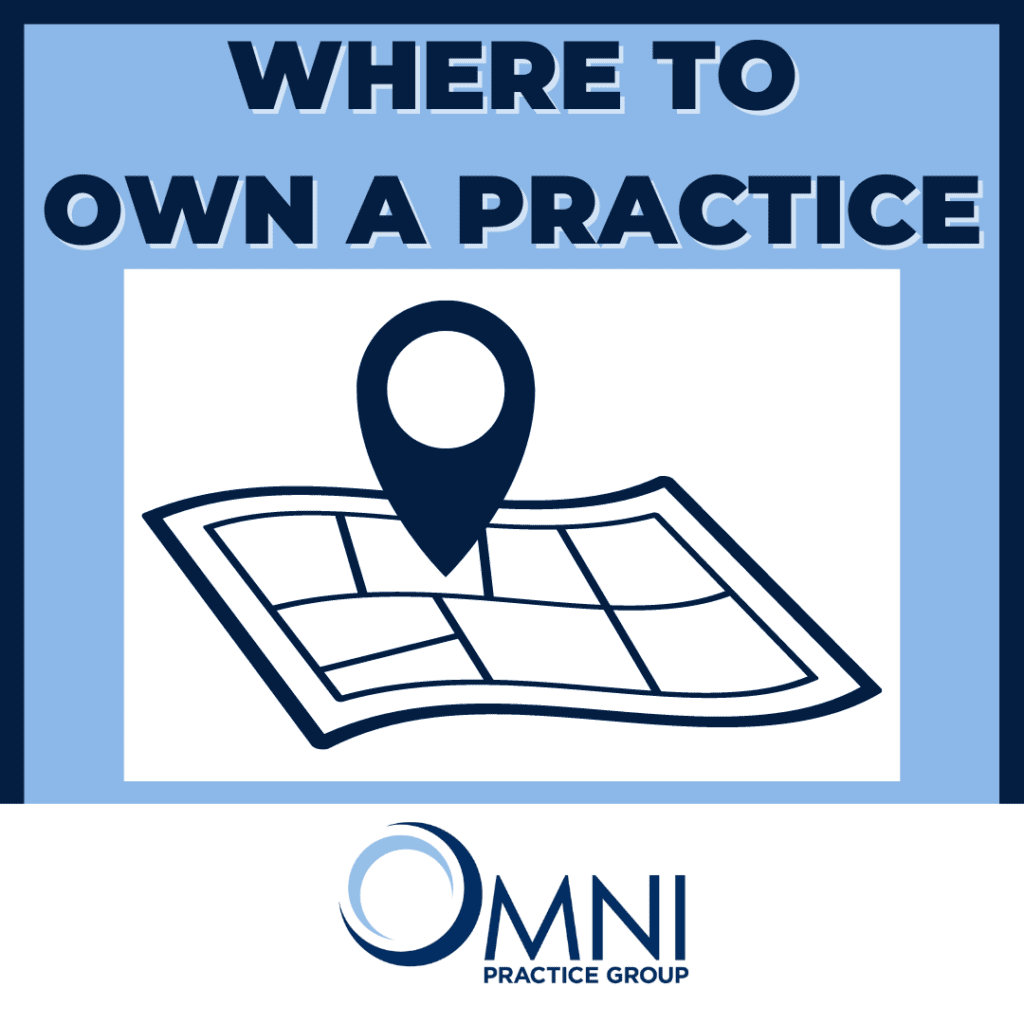Where to Own a Dental Practice?


If you are in it because you love dentistry and love helping patients and you are not necessarily in it to make the big bucks, you can really own a dental practice almost anywhere. A lot of buyers seem to want the downtown metropolitan practice thinking it’s a great place to practice since there are so many potential patients and you can live the urban lifestyle. I’ve helped doctors who absolutely wanted to be in a metropolitan area, even though the demographics made no sense whatsoever, who then started a practice and did quite well. One doctor that I helped always dreamed of owning a practice in a particular city. He went for it and is successful. And I have seen others want a practice in a certain area, and although the numbers didn’t make sense, they did it anyway and were successful.
Some of you are buying a practice because you want to make a lot of money, in which case, further analysis and discussion are needed. The failure rate for dentists is infinitesimal – somewhere around .0125%. If you’re buying an existing practice and you have identified that the practice already has good cash flow, you can purchase the practice and have success almost no matter where it is. If it’s a poor performing practice, you would need to examine if the poor performance is because of the location, the management, or something else. If you want to buy an existing practice and are looking for an opportunity to grow and have lower overhead, I would suggest looking outside of the metropolitan areas. Practices outside of metropolitan areas have less competition, wages and rents are lower, and it’s easier to grow those practices. And if you are considering doing a startup practice, the same rules apply. Look for a location with good demographics outside of metropolitan areas. Of course, if you absolutely want to be in a metropolitan area, don’t be afraid to go for it. Just look closely at the numbers and hire a good dental practice or real estate broker to help you out.
I do recommend that you do a bit of demographic analysis on the locale. See how many dentists are currently practicing in the area. A good ratio is 2,000 daytime population for each doctor. There is a difference between the daytime population and the regular population. The daytime population includes the workforce. For example, if you look at the population of South Lake Union during the day vs. the nighttime population, you would see a big difference. Another demographic to pay attention to is the age of the population. For a general practice, a good mix of young and old is best. If you want a high cosmetic practice, but the average age is 28, you might need to consider another area. Homeownership is another good indicator of practice success. You want to have more homeowners than apartment renters. You can obtain detailed demographics either through a company that will charge a fee and provides data such as the average annual dollar amount spent on dentistry per person within a zip code and other more granular items. Or, Omni has information that we can provide.
One of the advantages of working with Omni is that we have both dental practice brokers and real estate brokers to help you traverse the ownership trail in any way we can. Just give us a call at 877-866-6053 or email us at info@omni-pg.com and we’ll be happy to help get you started. Contact us today!
Read MoreWhat To Do with Your Practice If You Are Sick Or Dying?
Most of us have a vague notion of what retirement might look like but that’s where our planning usually stops. Getting sick or receiving a terminal diagnosis isn’t something that is easy to think about and is even more difficult to talk about. Nobody wants to contemplate their last moments in this world.
Sadly, we have all witnessed peers who have been thrown a curve ball and had an illness or untimely death. The aftermath of these events places a huge strain on our families. However, these stresses can be lessened with some discussion and at the very least, taking the steps now to get the right people in place when you need them.
An unexpected sickness can occur at the height of our professional careers. Depending on the prognosis, it’s critical to get our affairs in order as quickly as possible. Staff might suspect that something is amiss, and you can ask them to keep health issues confidential.
If you haven’t assembled a team already, start searching for a reputable estate-planning attorney and CPA. Also include the often-overlooked professional; a practice transition broker who can assist with the transition of your practice and can begin the process with you as soon as possible. Most widows/widowers are not thinking that the responsibility of selling the practice will fall on their shoulders. Start these delicate conversations with your spouse now, so they won’t be left to deal with this in addition to emotional stress.
If you are still able to work at your practice, we can begin to market the practice heavily but discretely so we can find a buyer as quickly as possible. The best medicine for you is to heal and take care of your family. Selling might seem short-sighted if you expect to make a full recovery, but there are many other options available if you still want to continue to work after you heal.
However, for those doctors who pass unexpectantly, word of mouth tends to get ahead of any marketing and the reality is that your practice will be marketed without a doctor and thus the practice value can decrease substantially. Some of the most difficult challenges that we have encountered are in serving spouses who are left to deal with quickly selling a practice when the doctor is sick or has passed away. The value of the practice drops sharply and is often valued at 30-40% less even after just one month without a doctor.
Prepare for the unexpected. Assemble your professional team and get your estate planning documents in order. Most importantly, make this information accessible and communicate your wishes with your spouse.
Life is short, spend your days doing what you enjoy and take care of your health.
Contact us today for a free consultation.
Read MoreBuy an Existing Practice or Build a New One?
We speak with hundreds of practice buyers each year. Many are looking for that gem of a practice in their desired area; a practice with new or newer equipment, digital technology, great location, recently remodeled, etc. Oftentimes, that practice either doesn’t exist; or if it does exist, it’s not for sale. So what’s a buyer to do – buy an existing practice or build one?
Omni is a rare breed in the practice broker world. We not only provide practice transition and valuation services for dentists – both buyers and sellers – we are also experts in helping dentists with their real estate needs. We are often asked in seminars, at conferences, or over the phone, “Should I buy an existing practice, or do a startup?” I often suggest that dentists spend some time looking for a practice in their desired location. If they can’t find one, they should consider starting a practice, especially if the doctor is 100% certain of the area in which they want to practice.
I recommend that dentists do a bit of demographic analysis on the locale. See how many dentists are currently practicing in the area. A good ratio is 2,000 daytime population for each doctor. There is a difference between the daytime population and the regular population. The daytime population includes the workforce. For example, if you look at the population of South Lake Union during the day vs. the nighttime population, you would see a big difference. Another demographic to pay attention to is the age of the population. For a general practice, a good mix of young and old is best. If you want a high cosmetic practice, but the average age is 28, you might need to consider another area. Homeownership is another good indicator of practice success. You want to have more homeowners than apartment renters. You can obtain detailed demographics either through a company that will charge a fee and provides data such as the average annual dollar amount spent on dentistry per person within a zip code and other more granular items. Or, Omni has information that we can provide.
If you perform the necessary research and find that opening a new practice in the area you like makes sense based on the numbers, we suggest that you go for it. We have helped many dentists over the years do demographic research, find a space, and negotiate a lease. Steve Kikikis is our go-to person for real estate leasing and sales. You can reach out to Steve anytime for help on whether you should buy an existing practice or build one by sending him an email at steve@omni-pg.com.
Read MoreShould I Pay Down My Student Debt Before Purchasing a Practice?
Nothing resonates more with recent college graduates than the talk of possibly wiping away student debt. Even though this might be a talking point of our current administration, it does bring up a question that newly graduated dentists worry about if they want to own their own dental practice. Should I pay down my student debt first? Or should I purchase a practice and then have two debts?
Your own gut reflex will say, “Uh, no way…more debt is crazy when I’m already so far underwater.” However, it is usually advantageous in the long run. If the dream of owning your own business is on your vision board, then it makes financial sense to move ahead with securing a business loan early in your career, even with a large amount of student debt.
Each person’s financial position will be unique. However, here are some items to consider:
Will it be harder to get a bank loan with a lot of student debt? Although not necessarily harder, the amount you can borrow will be determined by the amount of your student debt and your history of making regular and timely payments. Consistent payments and not skipping any repayments on your student loan will show the bank that you are reliable in your financial commitments. Although it’s tempting to splurge on extravagant items, keep your finances in check during this time and keep making regular payments. Banks like to see that you have a stable financial history and are not high-risk.
Which has the higher interest rate, the student loan or business loan? Whichever loan has the higher interest rate, is the loan you will want to pay down first. This might seem obvious but check with your lender for your student loan because they often don’t have harsh penalties if you lower your payment. Go back and recalculate what the minimum student loan payment is and take the difference you had been paying and use that towards your new business loan, hence paying the more expensive loan sooner.
Buying a turn-key practice or one that needs some work. Look for a dental practice that is undervalued, has potential, and is located in a good area. Most buyers want a turn-key solution when purchasing a practice. But there are a few diamonds in the ruff. The advantage is you will secure a loan for less money on an underperforming practice and with some work, you can turn it into a polished gem which is a great investment.
Building equity. You will earn equity in your business if you purchase a practice, rather than remaining an associate. As an owner, your earning potential is far greater, often outpacing the associate salary from the day you purchase a dental practice. If you purchase a practice where you own the real estate then you would also increase your bottom line when you are ready to retire and transition.
You haven’t missed the boat of owning your own dental practice when you have a large amount of student debt, but you will want to be business savvy on how you should proceed.
Read MoreThe Importance of Your CPA During a Transition
The Importance of Your CPA During a Transition. Megan Urban of Omni Practice Group talks about why a dental-specific Certified Public Accountant is critical during your practice transition. Regardless if you are a buyer or seller, you should have a CPA who specializes in dental transitions. If you are a seller, your CPA will help guide you through the complexities of taxes and what you may owe before the sale of your dental practice, so you’re not caught off-guard at closing. They can also advise on the health of your retirement accounts.
As each State has different tax regulations, your CPA can help you navigate these issues with you. If you aren’t currently working with a Certified Public Accountant and would like a recommendation of a dental-specific CPA in your home State, please reach out and we can provide you with details. You can also contact us today for a complimentary snapshot valuation to find out what your practice is valued at. Either email info@omni-pg.com, or call us at 877-866-6053.

